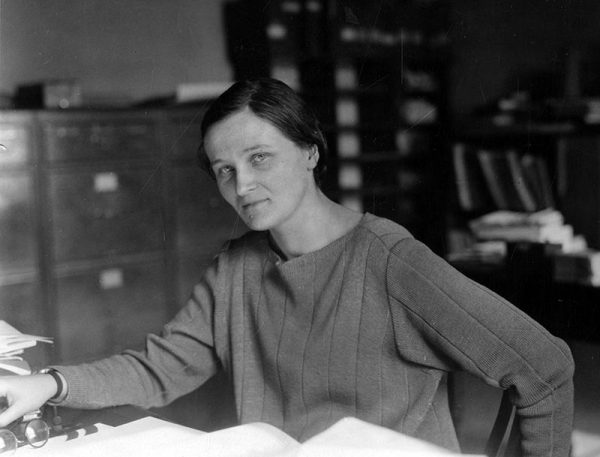The woman who explained the stars – Nature.com
What Stars Are Made Of: The Life of Cecilia Payne-Gaposchkin Donovan Moore Harvard Univ. Press (2020)
Male astronomers often achieve a popular fame that eluded one of the field’s most distinguished women: Cecilia Payne-Gaposchkin. That should be remedied by Donovan Moore’s engaging and accessible biography. It skilfully opens up Payne’s achievements and adventures by setting them in the global village of astronomy, against the turbulent social and historical backdrop of twentieth-century Europe and the United States.
In 1925, Payne was the first person to be awarded a PhD in astronomy at Radcliffe College, at the time the women’s branch of Harvard University in Cambridge, Massachusetts. Her thesis on stellar atmospheres is her greatest contribution: she related the line patterns in the observed spectra of stars to their physical conditions. She also discovered that hydrogen is the main component of stars, followed by helium. Her discoveries and expertise were eventually recognized with prizes and honours, culminating in a life-achievement lectureship from the American Astronomical Society.
The brilliance of Payne’s thesis was acknowledged by the most prominent US astronomers of the early twentieth century: her supervisor, Harlow Shapley, director of the Harvard College Observatory; and Henry Norris Russell at Princeton University in New Jersey. But both disagreed that hydrogen is the main component of stars. She based her theory on painstaking analysis of the large cache of stellar spectra in the Harvard collection. It was informed by the predictions of Indian physicist Meghnad Saha’s theory of ionization, which relates the observed spectrum of a stellar atmosphere (assuming it is a gas in thermal equilibrium) to its temperature, pressure and composition.
Her conclusion went against a view widely espoused by prominent astronomers, including Arthur Eddington: that stars are made up of essentially the same elements as Earth (silicon, carbon, iron and so on). In response to this criticism, and because she was anxious to get her results published, Payne downplayed her finding as a possible error. Russell was later credited with the discovery, having reached the same result by different means. Payne’s role stayed hidden from the wider scientific consciousness for several decades.
Reaching for the stars
Moore illuminates Payne’s development into a remarkable scientist. Her mother had extensive interests outside the home — a rarity in upper-class Edwardian England. Hours spent in the household’s library equipped Payne with a knowledge and appreciation of the classics, music and theatre. After the First World War, although shy, she won over mentors and sponsors to help her study physics at the University of Cambridge (which did not award degrees to women at the time). There, she was influenced by Eddington and atomic physicist Ernest Rutherford.
In 1923, Payne set sail for the United States at Shapley’s invitation, having secured funding to become a research scientist at Harvard College Observatory. Shapley promoted her talents, but also exploited her. He encouraged her research and at her request hired Sergei Gaposchkin, a Russian astronomer escaping Europe just before the Second World War, who eventually became her husband. But he paid her poorly, so that she and Gaposchkin could not afford childcare, and their three children were often seen playing at the observatory.
He also kept her low in the professional pecking order, even advising another institution against hiring her to a prominent position. She seems to have accepted this as a fact of life, but I wonder how things would have turned out had she received proper professional recognition earlier. It was only in 1954, after Shapley was replaced as director by Donald Menzel, that she received a reasonable salary. Two years later, at the age of 56, she was awarded a Harvard professorship.
Glittering society
Payne remained at the observatory until her death in 1979. The friends she amassed read like a who’s who of early-twentieth-century physics and astronomy. They included those responsible for pushing the new atom theory (Rutherford, J. J. Thomson) and astronomers who were instrumental, with her, in opening up the astrophysical approach to understanding the Universe and its components (Shapley, Russell, Menzel, Eddington). A reproduction of Payne’s portrait in oils now hangs prominently in the lobby of the Harvard–Smithsonian Center for Astrophysics — a belated tribute to her hard work and dedication.
I met Payne in the mid-1970s. I remember her as a stern, chain-smoking presence stalking the halls of the observatory: she scolded me for being late for a meeting (recently arrived from Italy, I regarded being precisely on time as impolite). After reading Moore’s well-researched book, I realized that she was a complex figure with whom I can empathize despite being two generations younger and from a different background. A committed scientist and mentor to a new generation, she successfully juggled career and family with a love of the arts and world travel.
Her autobiography (published privately as The Dyer’s Hand in 1979, and publicly as Cecilia Payne-Gaposchkin in 1984), is worth a read for its personal view of her multifaceted life and her interaction with observatory colleagues, including the female ‘computers’ who processed astronomical data. I also recommend for its immediacy her 1968 interview for the American Institute of Physics oral-history programme, conducted by Harvard astronomer and historian Owen Gingerich (see go.nature.com/37nm0vr). It captures her essential briskness and rare ability to talk in complex and nuanced sentences.







